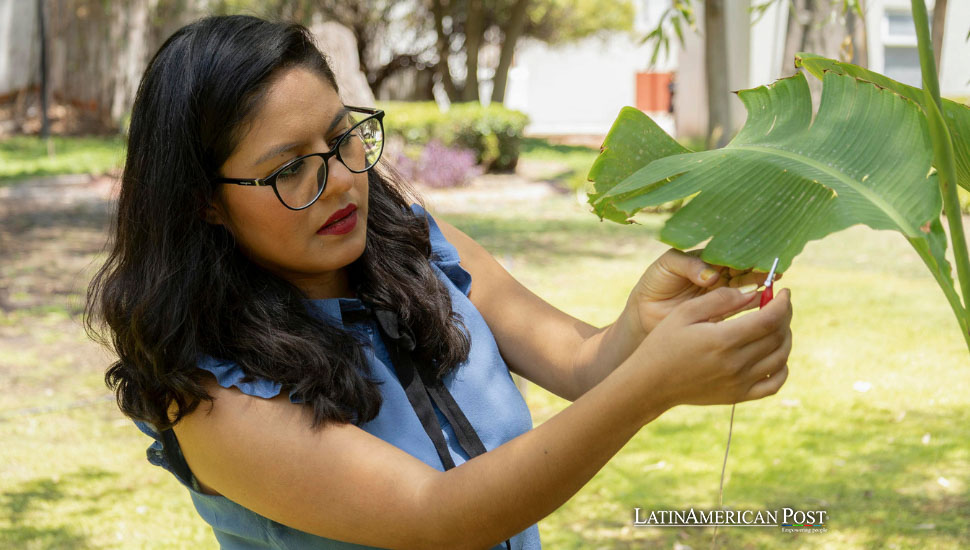Mexican Scientist Harnessing Technology to Create Music from Plant Sounds

Mexican scientist Laura Xóchitl Cruz has developed a device that produces music from plant sounds and now offers concerts in Querétaro, Mexico.
Mexican scientist Laura Xóchitl Cruz has made an extraordinary breakthrough by developing a device that generates music from the sounds produced by plants. This innovative project, born from her extensive research on the influence of sound on plant and pollinator growth, has led to immersive concerts and a unique connection between nature and people in Querétaro, a state in central Mexico.
Cruz, a Biosystems Engineer from the Autonomous University of Querétaro (UAQ), initially researched how sound affects plant development. Over the years, her work evolved to explore the musical potential of plants, leading to a fascinating discovery. “I started working with lettuces and exposing them to the noise they produce during their growth,” Cruz explained. “After completing that experiment at UAQ, I realized that the devices from that experiment could be used to listen to the music of the plants.”
Cruz’s device consists of electrodes connected to plant leaves. “You attach the electrodes to the plant, and then you can listen to the plant,” Cruz detailed. The interaction between humans and plants further enhances this experience. When you touch the plant, the sound changes, and if you put the electrodes on yourself, the sound varies with each person. Experiencing this interaction live changes people’s perception of nature significantly.”
These sounds are electrical impulses within each plant, which, when processed, link to the sounds of instruments, creating music. Cruz developed a processor that interprets these impulses and makes the necessary connections to produce specific sounds. “I developed the device because acquiring one from another country was difficult. This was about ten years ago, and it was even more challenging to bring things to Mexico back then,” Cruz recounted.
Bridging Technology and Nature
Cruz’s work extends beyond creating music. She aims to integrate sound technology into agriculture, potentially replacing expensive tools like pollinator drones with sound-based mechanisms to promote crop growth and benefit natural pollinators. “The type of frequencies used is crucial. They need to be specific depending on what you want to achieve, and it involves the decibels, the strength of the sound, and the exposure time,” Cruz elaborated.
Cruz’s device has two impacts: it offers an innovative way to engage with nature and provides practical agricultural applications. Her immersive concerts, held in various states across Mexico, promote science and foster a deeper appreciation and connection with nature among the audience. Cruz is pioneering a unique intersection of technology, art, and environmental awareness by converting plant impulses into music.
A Latin American Context
Cruz’s project highlights Latin America’s vibrant scientific and technological advancements. Integrating modern technology like Cruz’s device demonstrates a progressive approach to solving contemporary challenges in a region where traditional agricultural practices have long been dominant. The fusion of traditional knowledge with cutting-edge innovation exemplifies the potential for Latin American countries to lead in sustainable and technologically advanced farming practices.
With its rich biodiversity and agricultural heritage, Latin America provides a fertile ground for such innovations. Cruz’s work reflects a broader trend in the region towards embracing technology to enhance sustainability and productivity in agriculture. This movement is not only about adopting new tools but also about rethinking the relationship between technology and nature, creating solutions that are both innovative and ecologically sound.
The Future of Agricultural Innovation
Cruz envisions her technology playing a crucial role in transforming agricultural practices. Her research could lead to more efficient and sustainable farming methods by using specific sound frequencies to influence plant growth. This approach could reduce the reliance on chemical fertilizers and pesticides, promoting a healthier environment and more resilient crops.
Moreover, Cruz’s technology has potential applications beyond agriculture. Using plant sounds to create music opens up new avenues for art and education. Schools and community centers could use these devices to teach students about plant biology and environmental science more interactively and engagingly. Artists and musicians explore new creative expressions by incorporating plant-generated sounds.
Laura Xóchitl Cruz’s pioneering work developing a device to produce music from plant sounds represents a remarkable blend of science, technology, and art. Her innovative approach offers a new way to connect with nature and holds significant promise for advancing agricultural practices in Latin America. As Cruz continues to refine her technology and explore its applications, her work stands as a testament to the transformative power of creativity and scientific inquiry.
Also read: Ancient DNA Study Sheds Light on Maya Sacrifices in Mexico’s Chichén Itzá
By bridging the gap between nature and technology, Cruz is paving the way for a future where sustainable practices and technological advancements go hand in hand. Her concerts and research inspire a deeper appreciation for the natural world, encouraging us to listen more closely to the sounds of nature and recognize the intricate connections that bind us to the environment. Through her visionary work, Laura Xóchitl Cruz is making music and shaping a more sustainable and harmonious future.




